Best Rolex, Patek Philippe and Audemars Piguet Watches for Men and Women in NYC
(212) 730-5959 / (888) 342-9949
Rolex VS Patek Philippe
Heritage & Prestige: A Legacy of Excellence
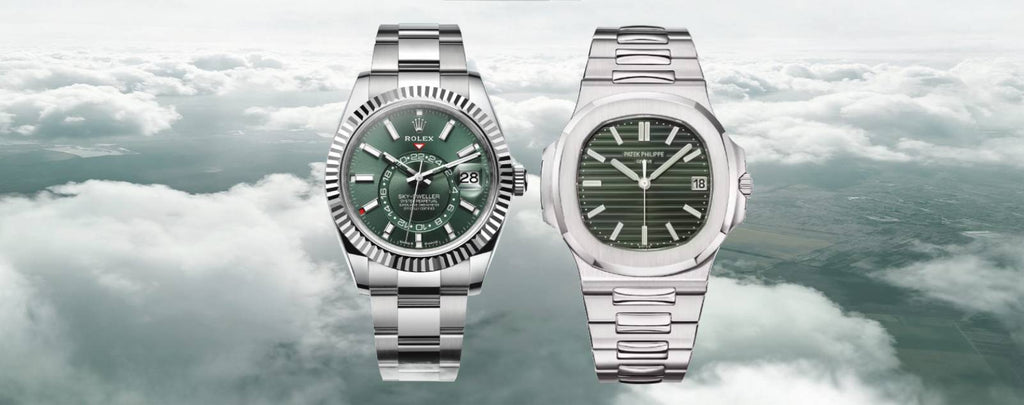
In the realm of luxury watches, two names reign supreme: Patek Philippe and Rolex. Both brands boast a rich heritage, impeccable craftsmanship, and a dedication to excellence that has captivated watch enthusiasts for generations. But what sets these titans apart? Let's embark on a journey to explore their history, legacy, and the prestige associated with owning a Patek Philippe or a Rolex.
Patek Philippe: A Legacy of Innovation and Artistry
Founded in 1839 in Geneva, Switzerland, Patek Philippe has established itself as a manufacturer of exquisite timepieces synonymous with artistry and innovation. They are renowned for their dedication to traditional watchmaking techniques, meticulous hand-finishing, and a relentless pursuit of creating the most intricate and reliable complications. Owning a Patek Philippe watch is akin to owning a piece of art, a testament to centuries of watchmaking expertise passed down through generations of master artisans.
Rolex: A Beacon of Innovation and Durability
Founded in 1905, Rolex, also hailing from Geneva, Switzerland, has carved a distinct path. While sharing a commitment to quality, Rolex prioritizes functionality, durability, and cutting-edge technology. Their iconic Oyster case, a water-resistant marvel, revolutionized the watch industry. Rolex is also known for its pioneering spirit, constantly pushing the boundaries of watchmaking with materials, features, and performance. Owning a Rolex signifies not just luxury but also a timepiece built to endure generations.
A Shared Passion for Precision
Despite their stylistic and philosophical differences, both Patek Philippe and Rolex share a deep respect for watchmaking traditions and a relentless pursuit of precision. Both brands employ highly skilled artisans who meticulously assemble each timepiece, ensuring exceptional quality and functionality. The movements within these watches, the very heart of their operation, are marvels of engineering, crafted from high-grade materials and designed to deliver unmatched timekeeping accuracy.
Key Points to Remember:
- Patek Philippe and Rolex are two leading luxury watch brands with rich heritages.
- Patek Philippe emphasizes artistry, innovation in complications, and traditional techniques.
- Rolex prioritizes functionality, durability, and cutting-edge technology.
- Both brands share a passion for precision and high-quality craftsmanship.
Signature Styles: Unveiling Design Identities
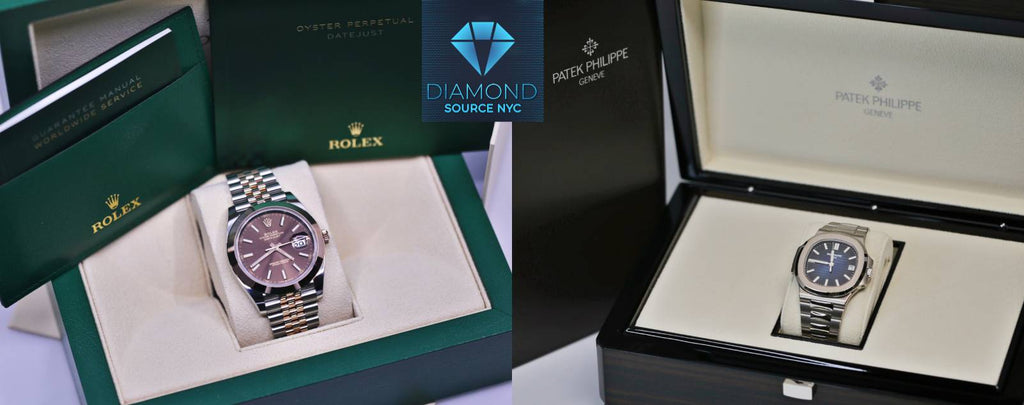
Patek Philippe and Rolex, while both undeniably luxurious, possess distinct design identities that cater to different preferences. Understanding these signature styles can guide you towards the brand that best reflects your taste and personality.
Patek Philippe: Timeless Elegance with a Touch of Opulence
Patek Philippe watches exude timeless elegance with a touch of understated luxury. Their designs are often characterized by classic round or rectangular cases crafted from precious metals like platinum, 18k gold, or rose gold. The dials typically feature clean layouts with intricate hands and meticulously applied hour markers. While some Patek Philippe models showcase stunning complications like perpetual calendars and moon phases, the overall aesthetic prioritizes balance and sophistication.
The Nautilus: A Sporty Sophisticate
A notable exception to Patek Philippe's classic repertoire is the Nautilus, a luxury sports watch first introduced in 1976. This iconic timepiece features a distinctive octagonal case with integrated bracelet, blurring the lines between dress watch and sporty elegance.
Rolex: Bold Statements and Unmistakable Icons
Rolex watches are known for their bold and robust designs. Their timepieces often feature larger cases, prominent bezels, and luminescent dials, making them ideal for everyday wear and adventurous lifestyles. Rolex utilizes a wider variety of materials, including their signature 904L stainless steel, alongside 18k gold and platinum for their precious metal models. Many Rolex models boast features like divers' bezels, chronograph functions, and Oyster Perpetual cases renowned for their water resistance.
The Submariner: A Dive Watch Legend
One of Rolex's most iconic designs is the Submariner, a pioneering dive watch first introduced in 1953. This legendary timepiece is known for its rugged construction, water resistance to impressive depths, and a clean, functional aesthetic that has transcended generations.
Choosing Your Ideal Style
Whether you gravitate towards the understated elegance of Patek Philippe or the bold functionality of Rolex, both brands offer exceptional quality and timeless design. Consider your lifestyle, personality, and the statement you want to make on your wrist when making your choice.
Key Points to Remember:
- Patek Philippe features classic designs with precious metals and clean layouts.
- The Patek Philippe Nautilus offers a sporty yet sophisticated option.
- Rolex boasts bold, robust designs with a focus on functionality.
- The Rolex Submariner is a legendary dive watch known for its durability.
- Choose the brand that aligns with your style, personality, and desired statement.
Inner Workings: Unveiling the Movements
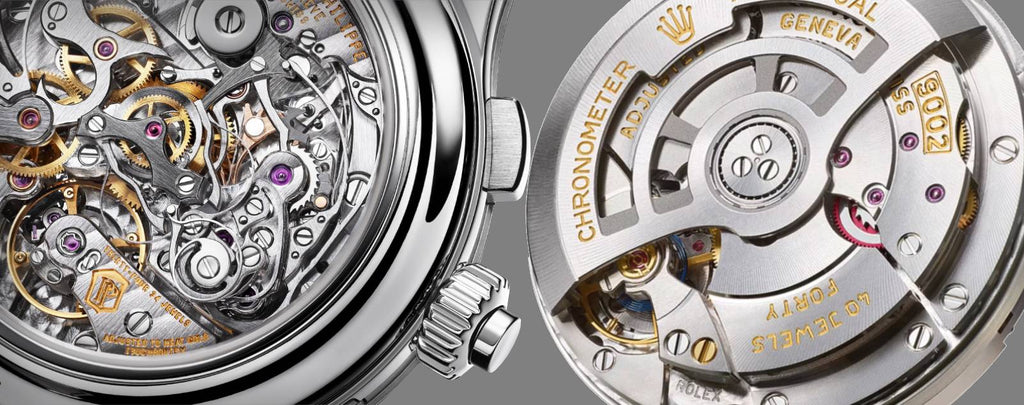
The beating heart of any watch is its movement, the intricate machinery that governs timekeeping. Understanding the movements within Patek Philippe and Rolex timepieces sheds light on their technical prowess and the level of precision each brand prioritizes.
Patek Philippe: A Symphony of Complications
Patek Philippe movements are renowned for their complexity and the sheer number of complications they can house. These complications, which can range from simple date displays to perpetual calendars, moon phases, and minute repeaters, showcase the brand's dedication to pushing the boundaries of watchmaking artistry. Each movement is meticulously assembled by hand, utilizing high-grade materials and intricate finishing techniques. Patek Philippe movements are known for their exceptional accuracy, reliability, and longevity, ensuring these timepieces are not just beautiful but also functional masterpieces.
The Caliber 89: A Testament to Innovation
A prime example of Patek Philippe's commitment to complications is the legendary Caliber 89. This masterpiece of watchmaking, unveiled in 1989, boasts 33 complications, making it one of the most complex mechanical watches ever created.
Rolex: The Power of the Oyster Perpetual
While Patek Philippe focuses on intricacies, Rolex prioritizes robustness and reliability in their movements. Their signature Oyster Perpetual movement, introduced in 1931, revolutionized the watch industry with its self-winding mechanism and exceptional water resistance. This dependable movement has been continuously refined over the years, ensuring Rolex timepieces deliver precise timekeeping under demanding conditions.
The Focus on Functionality
Rolex movements are built to endure. They utilize high-quality materials like Rolex's proprietary alloys and benefit from rigorous testing procedures. While some Rolex models do feature complications like chronographs and GMT functions, the overall emphasis remains on functionality and reliable timekeeping.
A Commitment to Quality in Every Movement
Despite their contrasting approaches, both Patek Philippe and Rolex movements share a dedication to exceptional quality. The meticulous assembly, use of high-grade materials, and rigorous testing procedures ensure that both brands deliver timepieces renowned for their precision and enduring performance.
Key Points to Remember:
- Patek Philippe movements are known for complexity and a high number of complications.
- The Caliber 89 exemplifies Patek Philippe's dedication to intricate watchmaking.
- Rolex prioritizes robustness and reliability in their Oyster Perpetual movements.
- Rolex movements are built for functionality and enduring performance.
- Both brands share a commitment to high-quality movements.
Crafting Excellence: A Look at Materials & Techniques
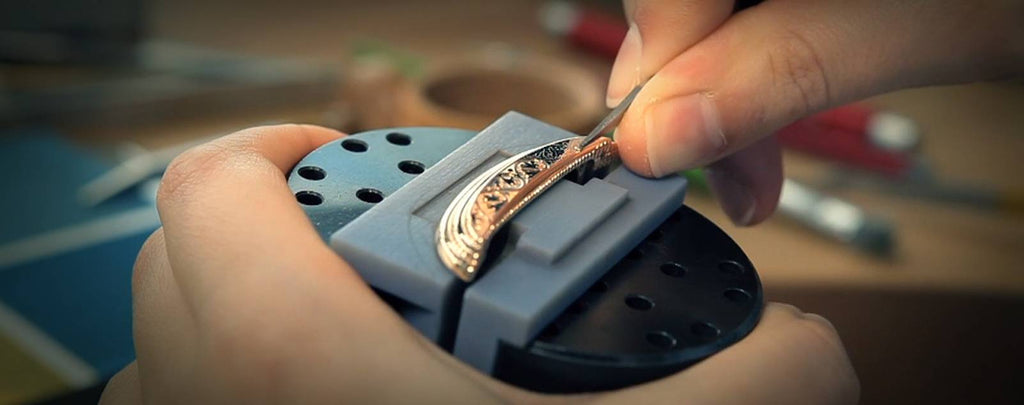
The exceptional quality and enduring beauty of Patek Philippe and Rolex timepieces are not just a result of their movements but also the meticulous craftsmanship that goes into every aspect of their creation. Let's delve into the materials and techniques employed by these luxury brands.
Patek Philippe: Masters of Traditional Watchmaking
Patek Philippe remains a champion of traditional watchmaking practices. Their artisans utilize a wide range of precious metals like platinum, 18k gold (white, yellow, and rose), and sometimes even titanium for their cases. These materials are meticulously shaped, polished, and finished to achieve a flawless luster and a luxurious feel. The dials on Patek Philippe watches are often hand-crafted using techniques like guilloche, a decorative engraving process that adds depth and texture.
Hand-finishing Touches
A hallmark of Patek Philippe craftsmanship is the extensive hand-finishing applied to every component. This meticulous process ensures exceptional smoothness in moving parts, enhances the visual appeal of the movement, and contributes to the overall longevity of the timepiece. The meticulous attention to detail and dedication to traditional techniques are what elevate Patek Philippe watches to the realm of haute horology (high watchmaking).
Rolex: A Blend of Tradition and Innovation
While Rolex respects watchmaking traditions, they also embrace innovation in their material selection and production techniques. They utilize their proprietary 904L stainless steel, known for its exceptional corrosion resistance, alongside 18k gold and platinum for their precious metal models. Rolex also employs cutting-edge manufacturing processes like laser cutting and computer-aided design to ensure precise component fitting and consistent quality.
The Oyster Perpetual Case: A Symbol of Innovation
A defining element of Rolex craftsmanship is the Oyster Perpetual case. This iconic design, patented in 1926, features a screw-down crown and a multi-piece case construction that ensures exceptional water resistance. Rolex continuously refines their manufacturing processes to ensure the Oyster Perpetual case lives up to its reputation for enduring even the most challenging environments.
A Shared Focus on Quality
Despite their approaches, both Patek Philippe and Rolex prioritize using the finest materials and employing skilled artisans to create their timepieces. This dedication to quality ensures that both brands deliver watches renowned for their durability, beauty, and ability to withstand the test of time.
Key Points to Remember:
- Patek Philippe utilizes precious metals and traditional watchmaking techniques.
- Hand-finishing is a hallmark of Patek Philippe craftsmanship.
- Rolex employs a blend of traditional and innovative techniques.
- 904L stainless steel is a signature material for Rolex.
- The Oyster Perpetual case exemplifies Rolex's innovative approach.
- Both brands prioritize quality materials and skilled craftsmanship.
Innovation vs. Tradition: Exploring Brand Philosophies

Patek Philippe and Rolex, while both undeniably luxurious, possess distinct brand philosophies. Understanding these core values can help you identify which brand better aligns with your preferences.
Patek Philippe: Guardians of Watchmaking Legacy
Patek Philippe views itself as a custodian of traditional watchmaking practices. They prioritize meticulous hand-craftsmanship, the use of high complications, and a timeless aesthetic that transcends fleeting trends. Their focus lies in creating heirloom pieces, built to be passed down through generations, showcasing the pinnacle of watchmaking artistry. Owning a Patek Philippe signifies not just a timepiece but a connection to a rich heritage and a commitment to preserving the art of haute horology.
Limited Production and Exclusivity
Patek Philippe deliberately limits its production volume, further enhancing the exclusivity of their timepieces. This approach allows them to dedicate more time and attention to each watch, ensuring exceptional quality and a level of detail that rivals fine art. The limited availability also contributes to the investment potential of Patek Philippe watches, making them coveted collector's items.
Rolex: Pioneers of Functionality and Performance
Rolex, on the other hand, embraces innovation and pushes the boundaries of watchmaking technology. Their core philosophy revolves around creating robust, reliable, and functional timepieces that excel in performance. Rolex is constantly developing new materials, incorporating cutting-edge features, and refining their manufacturing processes to ensure their watches perform flawlessly under demanding conditions.
A Focus on Utility and Everyday Wear
Rolex designs their watches to be worn and enjoyed, not just admired in a display case. Their iconic Oyster Perpetual case and focus on water resistance make their timepieces ideal for everyday wear, adventure, and even professional diving. Owning a Rolex signifies not just luxury but also a tool built to endure and perform for generations.
Respect for Tradition, But an Eye on the Future
While Rolex embraces innovation, they don't disregard tradition entirely. Their signature Oyster Perpetual case and many of their iconic designs, like the Submariner and Datejust, have stood the test of time, showcasing a respect for heritage alongside a constant pursuit of improvement.
Choosing Your Ideal Philosophy
Do you value the artistry and heritage embodied by a Patek Philippe, or are you drawn to the functionality and innovation championed by Rolex? Understanding these brand philosophies can guide you towards the timepiece that best reflects your personality and lifestyle.
Key Points to Remember:
- Patek Philippe prioritizes tradition, high complications, and timeless aesthetics.
- Patek Philippe offers limited production and exclusivity.
- Rolex embraces innovation, functionality, and performance.
- Rolex designs watches for everyday wear and demanding conditions.
- Both brands respect tradition but have distinct approaches to the future.
Scrutinize the Packaging & Papers: Separating Fact from Fiction
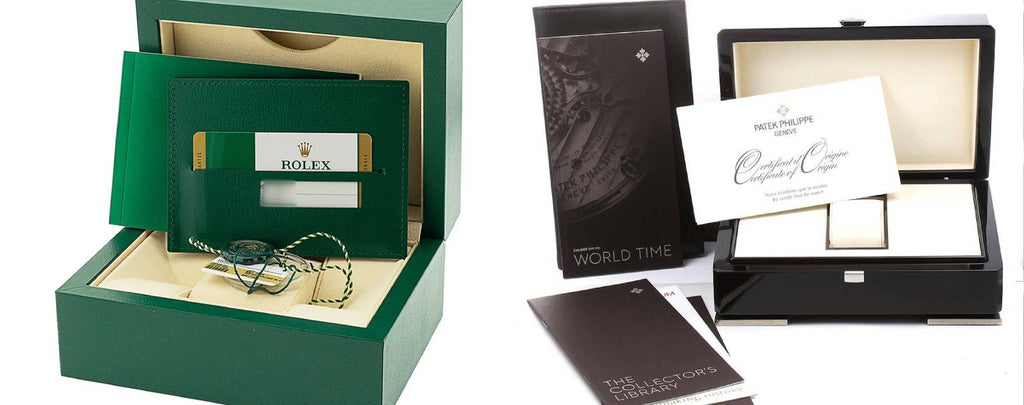
Owning a Patek Philippe or Rolex signifies not just a luxurious timepiece but also a treasured possession. Both brands take pride in the presentation of their watches, and the packaging and documentation serve as indicators of authenticity. Learning how to scrutinize these elements can help you avoid purchasing a counterfeit.
The Authentic Presentation Experience
Patek Philippe:
- High-Quality Presentation Box: A genuine Patek Philippe boasts a sturdy presentation box crafted from premium materials like leatherette or wood. The box should be well-maintained and free of any damage.
- Official Warranty Card: Every Patek Philippe comes with an official warranty card made from high-quality paper and featuring the watch's model number, serial number, and date of purchase. The warranty card should also include a matching hologram or security element for verification with Patek Philippe.
- Additional Documentation: Some Patek Philippe models may come with booklets or manuals detailing the watch's functions and proper care. These materials should be professionally printed and contain accurate information specific to the model.
Rolex:
- Signature Presentation Box: A genuine Rolex features a high-quality presentation box, typically crafted from green leatherette with a plush interior. The box should be free of any defects or inconsistencies in materials or logos.
- Official Rolex Warranty Card: Every genuine Rolex comes with an official warranty card printed on high-quality paper. It should display the watch's model number, serial number, and date of purchase. The warranty card should also feature a matching hologram or security element that can be verified with Rolex.
- Additional Booklets: Rolex models may include booklets or manuals detailing the watch's functions, operation, and proper care. These materials should be professionally printed and contain accurate information specific to the model.
Red Flags to Watch Out For:
- Flimsy Packaging: Counterfeit watches may come in flimsy cardboard boxes with cheap materials or poorly printed logos.
- Missing or Poorly Printed Documentation: Fake watches might lack warranty cards or have poorly printed documentation with typos, grammatical errors, or inconsistencies in information not matching the watch model.
- Unverified Security Elements: Counterfeit warranty cards might have fake holograms or security elements that don't match the brand's verification methods.
When in Doubt, Seek Professional Verification
If you're unsure about the authenticity of the packaging and papers, it's best to consult a professional watchmaker or a reputable jeweler. They can examine the materials, printing quality, and security elements to determine if the packaging and papers are genuine components from Patek Philippe or Rolex.
Key Points to Remember:
- Patek Philippe and Rolex have high-quality presentation boxes and official warranty cards.
- Look for well-maintained packaging, premium materials, and accurate documentation.
- Beware of flimsy boxes, poorly printed papers, or missing documents.
- Unverified security elements are a red flag for potential fakes.
- Consult a professional for verification if unsure about authenticity.
Demystifying Serial Numbers: A Crucial Step in Authentication
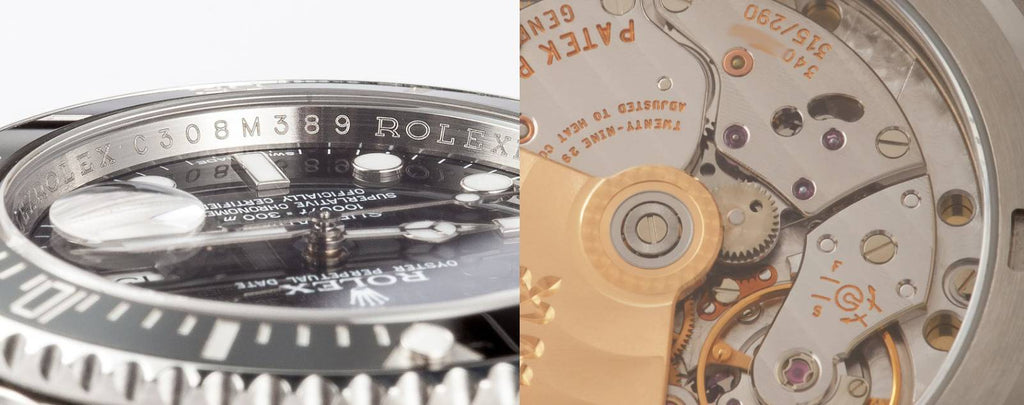
When considering a pre-owned Patek Philippe or Rolex, scrutinizing the serial number becomes a crucial step in verifying its authenticity. Both brands utilize unique serial numbers engraved on their watches to track production and ensure genuine ownership. Understanding how to locate and interpret these serial numbers can be a powerful tool in avoiding counterfeits.
Locating the Serial Number:
Patek Philippe:
- The serial number on a Patek Philippe watch can typically be found on the back of the case, engraved between the lugs (the protrusions that attach the strap or bracelet).
- In some older Patek Philippe models, the serial number might be located on the movement itself, visible through the case back if it's transparent.
Rolex:
- Rolex serial numbers are typically engraved on the rehaut (the ring inside the sapphire crystal that displays the hour markers).
- On some older Rolex models, the serial number might be located on the case between the lugs at the 6 o'clock position.
Understanding Serial Number Formats:
Patek Philippe:
- Patek Philippe serial numbers don't follow a universally consistent format. The format can vary depending on the model and year of production.
- However, genuine Patek Philippe serial numbers are typically alphanumeric, combining letters and numbers.
Rolex:
- Rolex utilizes a letter-and-number format for their serial numbers.
- The format has evolved over the years, but generally, the first letter or letters indicate the year of manufacture, followed by a sequence of numbers.
- Resources like online Rolex serial number databases can help you determine the approximate year of production based on the format.
Verification Through Brand Resources:
Patek Philippe:
- While Patek Philippe doesn't offer an online public database for serial number verification, you can contact them directly with the serial number and request a confirmation of authenticity. Be prepared to provide additional information like the watch model and any available documentation.
Rolex:
- Rolex doesn't maintain a public online database for serial number verification either. However, authorized Rolex retailers might have access to internal tools to assist with verification. Consider contacting an authorized Rolex retailer and presenting the watch and any documentation for verification.
Importance of Matching Documentation:
The serial number on the watch should always match the number displayed on the warranty card and any other relevant documentation. Inconsistencies between these numbers can be a strong red flag for a counterfeit.
Key Points to Remember:
- Locate the serial number on the case back or rehaut.
- Patek Philippe serial numbers vary in format but are alphanumeric.
- Rolex serial numbers use a letter-number format with changing formats over time.
- Contact the brand or authorized retailers for verification if needed.
- Serial number on the watch should match documentation.
Spotting the Telltale Signs: Identifying Counterfeits
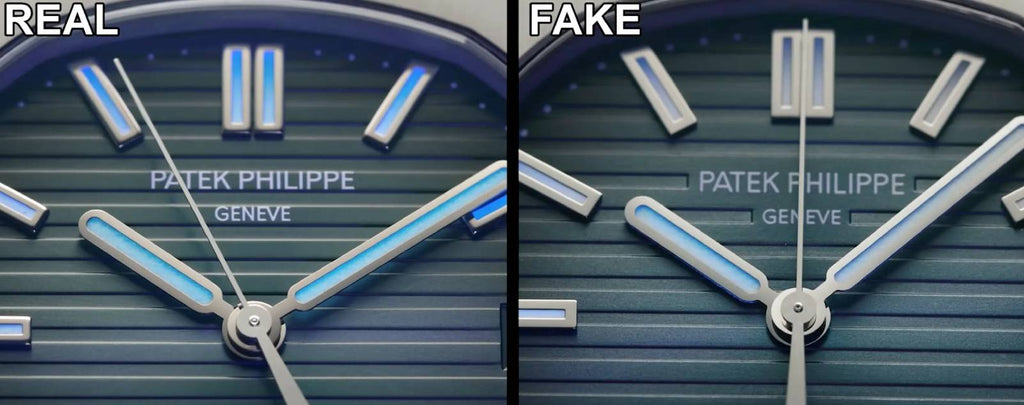
While Patek Philippe and Rolex represent the pinnacle of watchmaking, the allure of their luxury can unfortunately attract counterfeiters. Unfortunately, even sophisticated fakes can appear convincing to the untrained eye. This section equips you with the knowledge to identify potential counterfeits and ensure you're investing in a genuine Patek Philippe or Rolex timepiece.
Red Flags to Watch Out For:
- Unrealistic Price: If a Patek Philippe or Rolex is offered at a significantly lower price than market value, it's likely a fake. Genuine timepieces from these brands hold their value well, and deep discounts are uncommon.
- Questionable Seller: Reputable authorized dealers and established jewelers prioritize authenticity. Be wary of purchasing from unknown online sellers or individuals without a proven track record.
- Flawed Craftsmanship: Examine the watch closely for imperfections. Genuine Patek Philippe and Rolex timepieces showcase meticulous craftsmanship. Look for misaligned hands, uneven finishes, or poorly printed markings as potential signs of a fake.
- Suspicious Packaging and Papers: Counterfeit watches often come in poorly made boxes with cheap materials or logos that don't match the brand's quality standards. The warranty card and any manuals might be missing, contain typos, or have inconsistencies in information.
- Unverified Documentation: Genuine warranty cards typically include security elements like holograms or unique serial numbers that can be verified with the brand. Counterfeit documentation might lack these elements or have non-functional verification methods.
Utilizing Online Resources:
- Brand Websites: Both Patek Philippe and Rolex offer resources on their websites to help identify counterfeits. These resources often include high-resolution images of genuine watches and details on security features to look for.
- Watch Enthusiast Forums: Online communities dedicated to watch collecting can be a valuable resource. Experienced collectors can offer insights and guidance on spotting fakes based on specific details or markings.
Seeking Professional Help:
If you're unsure about the authenticity of a watch, especially when considering a high-value timepiece, consulting a professional watchmaker or appraiser is highly recommended. They possess the expertise to examine the watch's movement, construction, and documentation to determine its genuineness.
Protecting Your Investment:
By educating yourself about the telltale signs of counterfeits and utilizing available resources, you can significantly reduce the risk of purchasing a fake. Remember, investing in a genuine Patek Philippe or Rolex is an investment in quality, heritage, and potentially, a lasting heirloom.
Key Points to Remember:
- Unrealistic price, questionable seller, and flawed craftsmanship are red flags.
- Scrutinize packaging, papers, and documentation for inconsistencies.
- Utilize brand websites and watch enthusiast forums for resources.
- Consult a professional watchmaker or appraiser for verification.
Beyond the Wrist: The World of Patek Philippe & Rolex Collecting
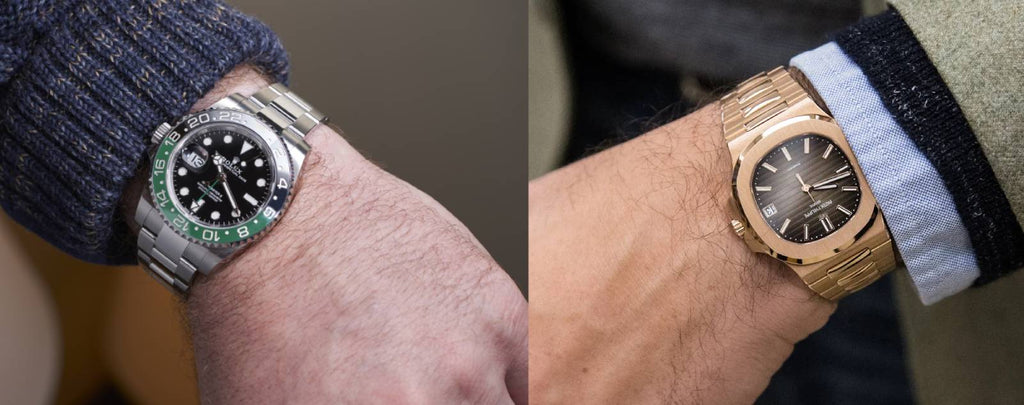
Owning a Patek Philippe or Rolex watch can be more than just a personal statement; it can be a gateway to a vibrant world of collectors and enthusiasts. This section explores the exciting world of Patek Philippe and Rolex collecting, highlighting the unique communities and experiences it offers.
A Passion for Timekeeping:
- Connecting with Fellow Enthusiasts: The world of Patek Philippe and Rolex collectors is a passionate one. Joining online forums, attending watch shows, or visiting collector groups allows you to connect with individuals who share your appreciation for these iconic brands.
- Learning from Experts: The collector community is a wealth of knowledge. Experienced collectors can offer valuable insights into the history, specific models, and the intricacies of watchmaking, enhancing your understanding and appreciation for your timepiece.
- The Thrill of the Hunt: Part of the allure of collecting lies in the pursuit of rare or coveted models. Collectors often dedicate time and effort to searching for specific timepieces, adding an element of excitement and satisfaction to the hobby.
Investing in Timepieces:
- Appreciation in Value: As discussed earlier, both Patek Philippe and Rolex watches have a strong track record of retaining or even increasing their value over time. This makes them not just luxury goods but also potential investment pieces for discerning collectors.
- The Value of Provenance: The history and ownership of a timepiece can significantly impact its value. Collectors often seek watches with well-documented provenance, adding another layer of intrigue and value to their collection.
- Building a Legacy: Many collectors view their collection as a legacy to be passed down to future generations. Owning a piece of watchmaking history from Patek Philippe or Rolex can become a cherished family heirloom.
Tailoring Your Collecting Journey:
The world of collecting offers a unique experience for everyone. You can choose to focus on a specific brand, model family, or even a particular era of watchmaking. The key is to define your interests and build a collection that reflects your passion and personality.
Key Points to Remember:
- Patek Philippe and Rolex have vibrant collector communities.
- Collectors connect, learn, and share their passion for watches.
- Patek Philippe and Rolex watches hold potential investment value.
- Provenance can significantly impact a watch's value.
- Build a collection that reflects your interests and passion.
The Final Choice: Selecting the Timepiece That Speaks to You

Ultimately, the choice between Patek Philippe and Rolex comes down to personal preference and what resonates most with you. Here's a final breakdown to help guide your decision:
The Patek Philippe Aficionado:
- Drawn to Heritage and Legacy: You value the rich history and tradition embodied by Patek Philippe. Owning a Patek Philippe signifies a connection to centuries of watchmaking artistry.
- Appreciating High Complications: You crave the intricate mechanics and craftsmanship evident in Patek Philippe's high complication timepieces. The artistry and functionality of these complex watches hold a special allure.
- Exclusivity and Investment Potential: The limited production and potential for significant value appreciation of Patek Philippe watches are important factors in your decision. You view your timepiece not just as a luxury good but also as a potential heirloom.
The Rolex Enthusiast:
- Functionality and Performance: You prioritize a robust, reliable, and functional timepiece built to withstand everyday wear. The iconic Rolex Oyster Perpetual case and focus on performance are key factors in your choice.
- Recognizable Luxury and Status: The timeless design and undeniable brand recognition of Rolex resonate with you. Owning a Rolex signifies a certain level of achievement and luxury.
- Investment Potential with Everyday Use: While exclusivity is a factor, you value a timepiece that can be enjoyed daily while retaining its value as a potential investment over time.
Finding the Perfect Fit:
Regardless of your choice, both Patek Philippe and Rolex represent the pinnacle of watchmaking. Consider visiting authorized dealers to try on different models and experience the craftsmanship firsthand. Let your personal taste and priorities guide you towards the timepiece that speaks to you on an emotional level.
A Timeless Investment:
Whether you choose the heritage and artistry of Patek Philippe or the functionality and status of Rolex, you're investing in a timepiece that transcends fleeting trends. A genuine Patek Philippe or Rolex watch is a testament to quality, a symbol of luxury, and potentially, a cherished heirloom to be passed down for generations to come.
Key Points to Remember:
- Patek Philippe appeals to those who value heritage, high complications, and exclusivity.
- Rolex caters to those who prioritize functionality, performance, and recognizable luxury.
- Try on different models and choose the timepiece that resonates with you.
- A Patek Philippe or Rolex is a timeless investment.
